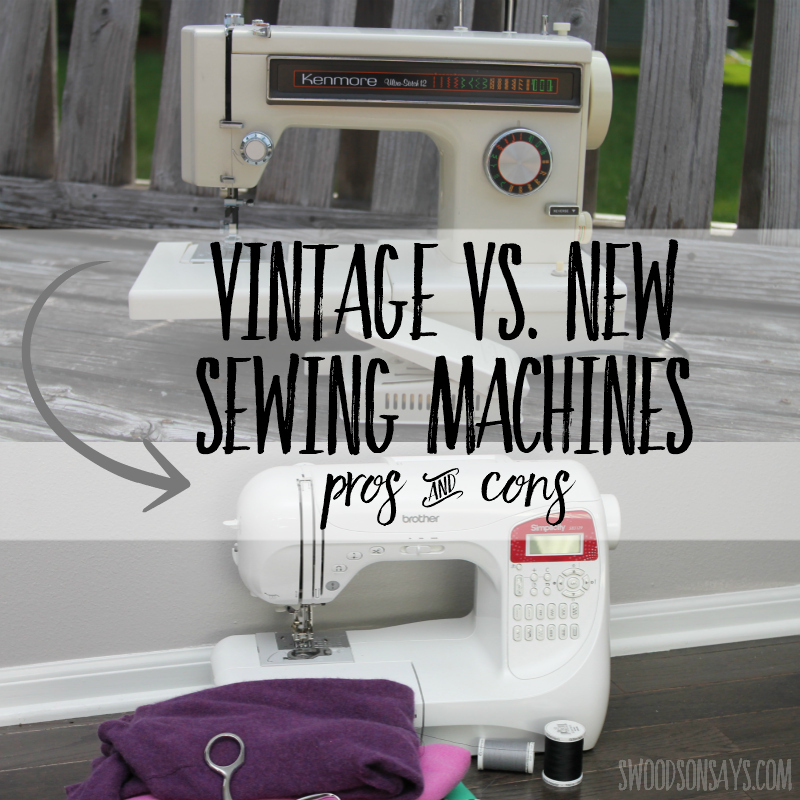
The debate of vintage sewing machine vs new can get heated! Often found in Facebook sewing groups, someone innocently asks “I’m looking for a beginner machine, any suggestions?”, not 5 seconds later, people swoop in to clamor about how vintage machines are the best. Their parts are made from metal! They are more reliable! They are better quality! I always chime in with my experience, and decided to write it out into a full blog post instead. I’d love to hear your experiences with vintage sewing machines vs new, in the comments, too!
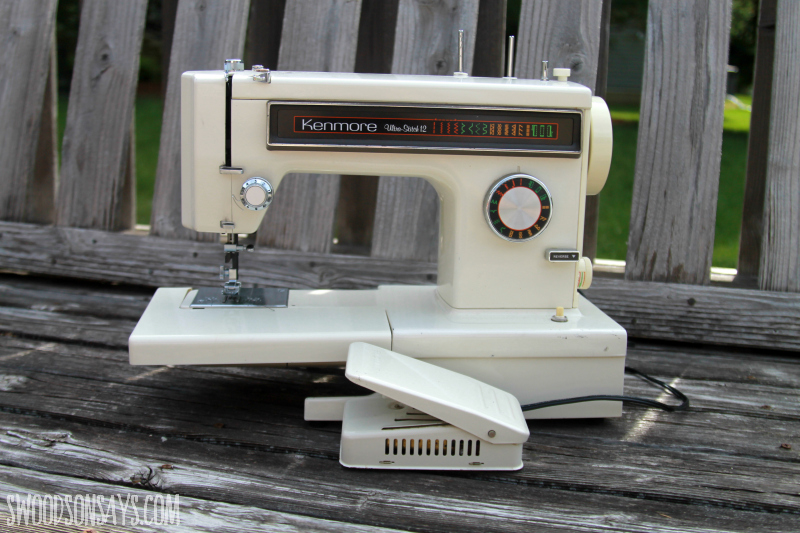
This is the vintage Kenmore sewing machine that I inherited from my Grandma when she died. She sewed, my Mom sewed, and once I got pregnant with my first child, I finally learned to sew. I’m not a particularly sentimental person, but I loved the idea of making things for my son, on a machine that made things for my Mom. I read the manual, I cleaned it carefully, and I dove in.
Except it was more like a bellyflop! I stopped and started so many times, because I’d get frustrated with the process or the results. Looking back, a few of the projects I failed on were user error like choosing the wrong fabric (bulky home dec for a roll-up shopping bag) or too difficult for a beginner (alphabet shaped pillows) BUT even more of the projects that frustrated me, were beyond my control.
The tension knob was temperamental, leading to constant fiddling and fixing. I took it in, sunk in $100 for a cleaning and a tension knob replacement, was thrilled for a week until… the knob was wonky again. I spent hours of time, trying to rethread, replace, tweak so it would behave. My baby wouldn’t sleep, my sewing machine wouldn’t cooperate, the hobby that I thought would be “me time” was just as frustrating as the rest of my day! Finally, I’d had enough.
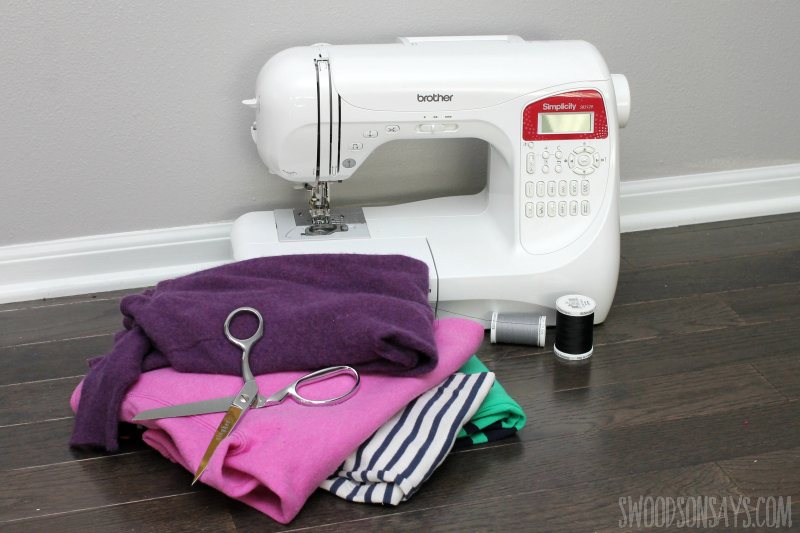
I visited the local Janome & Brother dealers to see what they had, was absolutely repelled by the Janome salesperson, and cringed my way through a $400 machine purchase at Brother. The salesperson showed me all the bells and whistles, with a stop/start button, automatic threading, but I couldn’t stop smiling because it just.. sewed. No tweaking. No jiggling. It sewed! Straight and true.
I wasted months of stopping & starting, frustrated at the machine’s limitations, and not knowledgeable enough to understand when it was me or the machine. If I hadn’t grown up around sewing, I surely would have given up! While vintage machines might be heavier, sturdier, more well made, they can also be finicky and expensive to fix at a shop (emphasis on the can! I know they can also be wonderful and well made and totally worth it). It pained me to stop using my handmedown Kenmore, but I think my Grandma would be happier that I’ve truly learned how to love sewing, by letting go of her machine.
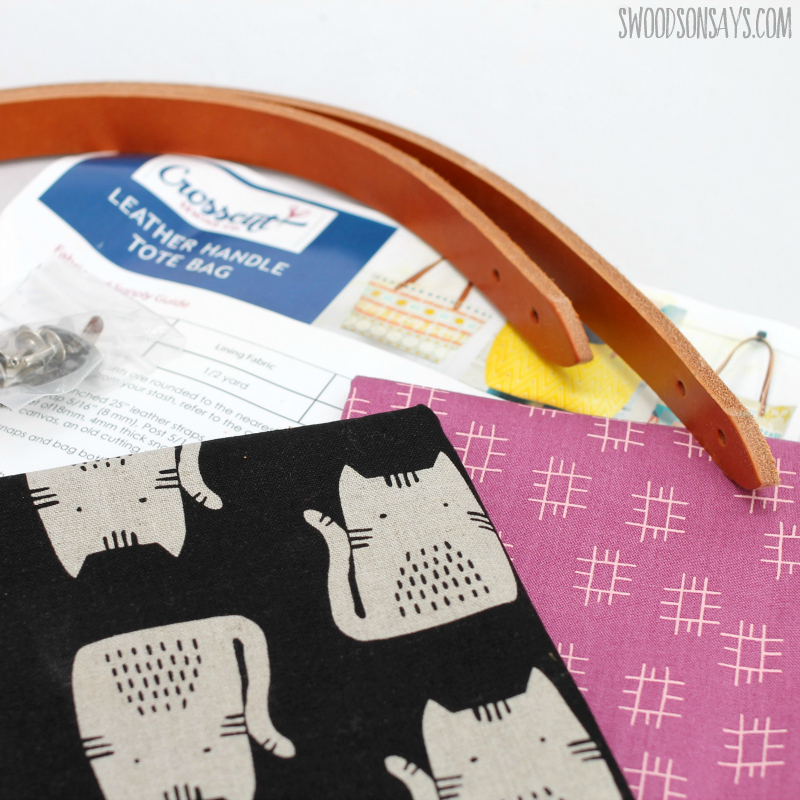
So what do I think a beginner should do in the vintage sewing machine vs new debate?
I think the best case scenario is shopping with a local dealer or buying from a trusted reseller who can show you the ropes in person. Not only does this cut down on packaging, it keeps your money in your local economy! You’ll have someone who you can go back to with questions, who can tell you to just change the needle instead of taking it in for a full cleaning.
BUT I also understand, that like me, sometimes you are learning and working in tiny bits of time, in between naps. I understand that it can be inconceivable to take 3 hours out of a day to visit a shop when you’re nursing a tiny person and working around naps! So, I also have my recommendation for the best new machine to order off Amazon below and some pros & cons to consider when considering vintage vs new sewing machines.
Vintage sewing machine vs new pros & cons
I realize ‘vintage’ will mean different things to different people. I don’t remember how old my Kenmore was, but it had different stitch options and was maybe not old enough to be vintage? So, remembering that, the pros & cons I can think of for each option:
Vintage machine – pros:
- Made to last for decades
- Metal parts – hard to break
- Issues are often cheaper to fix because they are mechanical, as opposed to computerized
- Though they weren’t built for knits, they were built for thicker fabrics and can handle heavier weights with ease
- Can often be found for free or inexpensive
- Saving something from the landfill
Vintage machine – cons:
- It can be expensive or challenging to find replacement parts, manuals, cords, etc.
- Many only have a straight stitch, which isn’t ideal for sewing knit fabrics
- After being used for years, may have quirks or issues that are difficult for a beginner to diagnose and/or fix
Modern machine – pros:
- More bells & whistles – the automatic button hole function is amazing!
- Possibly comes with a warranty or service package, if purchased new
- Plastic parts mean they are lighter, easier to travel with
- More popular machines often have specific video tutorials for how to use them, online, which is great for beginners
- Some functions may make sewing more accessible – for example, I have an old back injury and it is so much more comfortable for me to sew using the button (no foot pedal!)
Modern machine – cons:
- Computerized displays are more expensive to fix – often repairs on cheaper machines aren’t worth it, it makes more sense to just buy another one
- Environmental aspects of buying new (packaging) & buying modern (planned obsolescence)
So what new machine would I recommend for beginners, if you don’t have a local shop or can’t get to one and want to shop online? This one! (and check out my post of easy sewing projects for beginners, to get a head start!).
It has amazing reviews, several people who I know and trust have used it for years and recommended it, and I have had great luck with Brother brand (they aren’t, and have never paid me! I just like their machines).
This is not the machine I have in the pictures up above! I have the Simplicity SB3129, which I bought from the dealer, the Amazon equivalent is the Brother Project Runway PC420PRW. I am very happy with it, but it is pricey for a beginner machine.
So, that is why I’m glad I ditched my older machine for a newer one. But, if/when I need or want a new machine? I’ll definitely consider a vintage one again, especially now that I am more experienced in trouble shooting machine errors and confident in my sewing ability!
What is your experience with vintage sewing machine vs new? Share in the comments!
Pin this post about vintage sewing machine vs new for later:
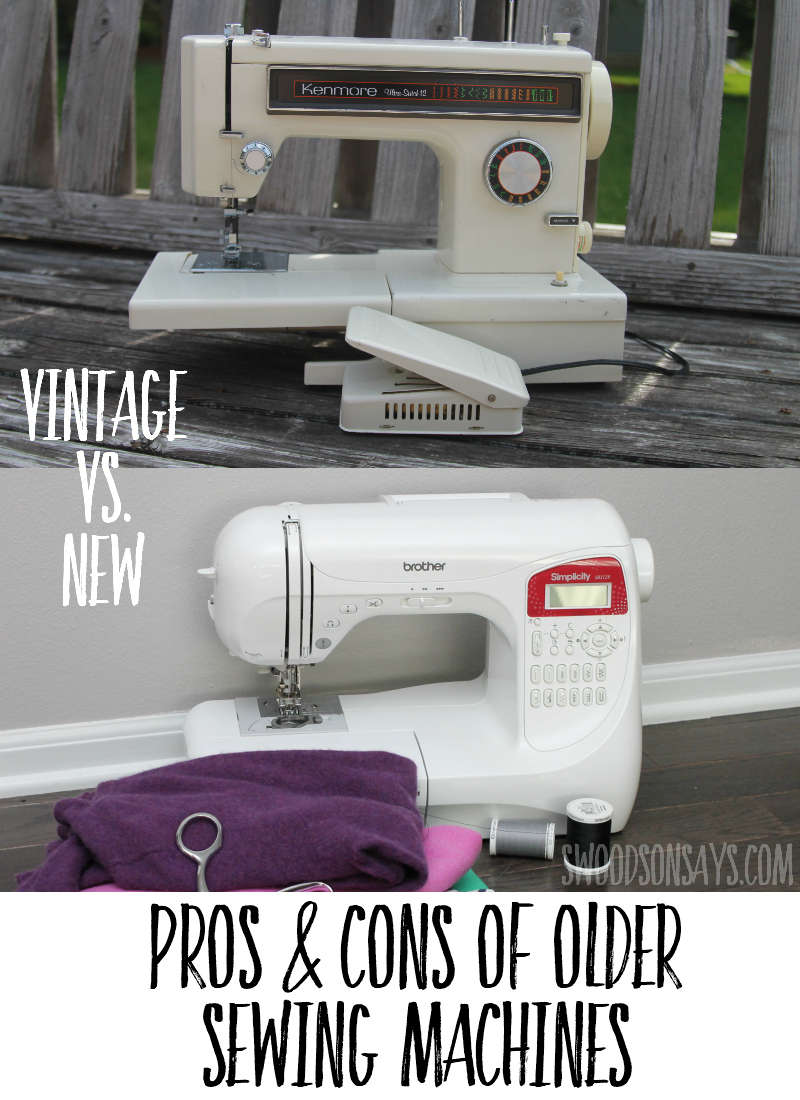
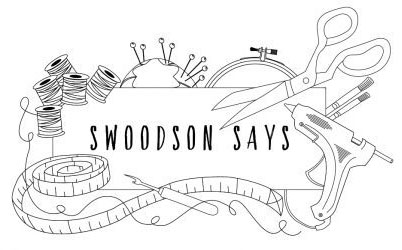
Oretsina
Sunday 23rd of July 2023
My experience has been that my newer machine, a 12-year old, $2400 Pfaff, had to be end of lifed because the plastic camshaft broke. The service technician told me it was because the camshaft plastic had become brittle, and no replacement parts were available for this 12 year old machine. All along during ownership, there were issues with the machine’s LED panel by the needle going out, the technician fixing it temporarily, and it then going out again following a few uses. It was essentially a black box that the owner could not perform servicing other than cleaning the bobbin area. On the other hand, my 1970 and 1980 vintage Bernina 800 series machines are going strong. Purchase price for both machines was $800 with their standard accessories. They are reliable, basic machines that, for the most part, I can service myself. Replacement parts are available, though sometimes aftermarket. No they may not have many, many stitch options, but how often do you use all of those? They have zigzag, straight and overlock and stitch quality is wonderful. They can handle heavier fabrics. When a bulb burns out, I can replace it!
LisaM
Sunday 25th of June 2023
My Kenmore didn't start out as a vintage machine in 1972. It did, however, survive my teenage years sewing absolutely everything and not stopping to think about the suitability of the machine. I kept it for lighter tasks even once I purchased an industrial machine in the early 1980's. I sold or gave away (I don't remember which) both machines when I ran away and joined the Army. By that point I knew that I would never use a lot of fancy features on any sewing machine, so when I finally broke down and purchased a new machine today, I bought a no-frills, heavy duty Singer 4411. Probably not the very best choice for most, but I really only need straight stitch and a little zigzag from time to time. I need a large number of feet, though--piping, zipper, rufflers, pleaters and so on. Those I know I'll use. What I don't care about is preprogrammed (or self-programmed) embroidery stitches.
I suspect this isn't what most sewers today want in a machine. I've always been a bit different. I don't like sewing knits, and never have. I do like using traditional tailoring techniques involving a lot of hand stitching and pressing. My grandmother taught me to sew. She was born around 1908, and she was an amazing seamstress and needlewoman.
Debbie H.
Saturday 24th of June 2023
I'm still amazed that you had the exact same machine. However, how do you do hems? Did you have to get a serger? I wish you could make hems like that on a regular machine.
Debbie H.
Saturday 24th of June 2023
I can't believe it! I have the exact same vintage machine. I am thinking it is from the mid-70's. I am probably your grandmother's age...lol. I, too, was looking for a new machine as I am always having to adjust the tension, but I NEVER get it right. I enjoyed reading your story! My big thing is I want a sewing machine table, but not sure a new one would fit. I don't have anybody to help me modify this old one. Anyway, thanks for the advice. I, too, just want a good straight stitch, even though I made all my own clothes wayyyy back in high school. God bless!
Stephanie - Swoodson Says
Monday 3rd of July 2023
thanks for reading and sharing Debbie!
Der
Monday 17th of April 2023
I have a singer 301 slant head. It goes forwards and backwards goes through 3 to 45 layers of denim and I wouldn’t get rid of it for the world but I also have a newer Janome that is a good machine.